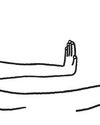
Every artist confronts her past, and, in the case of the Indian dancer Bijayini Satpathy, that past is both a country and a colonial legacy. Satpathy performs Odissi, a dance style from the eastern state of Odisha which is one of India’s eight classical dance forms. Although Indian classical dance is commonly assumed to be ancient and reverential—and there is a documented history of devotional dancing extending back more than two millennia—all eight of these designated classical styles are modern, post-colonial inventions.
Even before the British formally departed the country, in 1947, Indian authorities had set out to give their emerging nation its own indigenous theatrical arts, and gurus and dancers from various regions began assembling standardized forms out of a dizzying variety of local practices and traditions. By 1952, four of these freshly codified dance styles—bharatanatyam, kathak, kathakali, and manipuri—had been formally recognized by the government, and given an élite Western stamp, “classical,” a word that, as Anurima Banerji points out in her book “Dancing Odissi,” had no true equivalent in Indian languages until British rule. Exponents of Odissi pushed for inclusion and exhibited the form at a landmark meeting in New Delhi in 1958, with Nehru himself presiding over a celebratory reception. Odissi gained official recognition two years later and has since been joined by other newly defined forms.
This story is from the January 15, 2024 edition of The New Yorker.
Start your 7-day Magzter GOLD free trial to access thousands of curated premium stories, and 9,000+ magazines and newspapers.
Already a subscriber ? Sign In
This story is from the January 15, 2024 edition of The New Yorker.
Start your 7-day Magzter GOLD free trial to access thousands of curated premium stories, and 9,000+ magazines and newspapers.
Already a subscriber? Sign In

BADDIE ISSUES
\"Wicked\" and \"Gladiator II.\"

LET'S MAKE A DEAL
\"Death Becomes Her\" and \"Burnout Paradise.\"

ANTI HEROES
\"The Franchise,\" on HBO.

FELLOW-TRAVELLERS
The surprisingly sunny origins of the Frankfurt School.

NOW YOU SEE ME
John Singer Sargent's strange, slippery portraits of an art dealer's family.

PARIS FRIEND - SHUANG XUETAO
Xiaoguo had a terror of thirst, so he kept a glass of water on the table beside his hospital bed. As soon as it was empty, he asked me to refill it. I wanted to warn him that this was unhealthy - guzzling water all night long puts pressure on the kidneys, and pissing that much couldn't be good for his injury. He was tall, though, so I decided his insides could probably cope.

WILD SIDE
Is Lake Tahoe's bear boom getting out of hand?

GETTING A GRIP
Robots learn to use their hands.

WITHHOLDING SEX FROM MY WIFE
In the wake of [the] election, progressive women, who are outraged over Donald Trump's victory at the ballot box, have taken to social media with public, vengeful vows of chastity. - The Free Press.

DEADLINE EXTENSION
Old age, reborn.